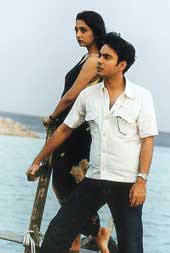 |
| June Maliah and Ayan Mitra in a scene from Nil Nirjane |
It is a story about relationships — between a mother and her daughter, a father and his daughter and two young friends, to name just a few. Peace, quiet and serenity, the reason that these individuals have escaped to a remote destination, are destroyed by the arrival of a band, Cactus, to shoot for a music video at the location.
Nil Nirjane is a movie of many firsts. The first time that Moon Moon and Raima Sen play their real-life roles in a film. The first time that a Bangla band has been cast in a Tollywood film, where they play themselves. The first time that Raima lends her voice to a song in a cinema. And above all, this Bengali movie, slated for release on March 21, is the “first digitally-made film in India” for commercial release.
Although a “relatively infrequently-used” medium of film-making, the reason the technology was used for Nil Nirjane was “entirely practical”, according to director Subrata Sen and producer R.K. Rungta. “It was not a question of breaking barriers. Rather, we were concerned with doing the best job we could within the budget we had. And going digital was what made it possible,” explains Sen.
The “impossible parts” to shoot on celluloid, and what prompted the decision to turn to upgraded technology, were the song sequences. “Each song had 150 cuts, which made smooth merging such an important factor,” says producer Rungta. “About 400 ft of celluloid film would have given us 45 minutes of footage. The digital tapes gave us three hours. This also meant that the cumbersome celluloid cameras did not have to be frequently dismantled to change the film.” Sen adds that since digital cameras are cheaper, they had the luxury of taking shots from multiple angles using several cameras, not usually possible on “Tollywood budgets”.
A number of pros clinched the digital deal for the film-makers — non-linear editing, which made it easier to create effects like fade-ins, fade-outs and colour ranging; sync sound, a silent recording system on the camera that cuts out the usual hum of a celluloid camera, eliminating the need to go for dubbing; and almost no difference in quality. In fact, all stops were pulled out with the film’s six songs, composed by Cactus, being mixed in Mumbai on Dolby digital soundtrack. And the music mixing was done by Biswadeep Chatterjee, of Devdas fame.
However, veteran editor and “the only man in the country to have edited a digital film”, Rabiranjan Maitra, feels that there is a wrong perception about digital film-making. “It is no cheaper than celluloid. After Nil Nirjane, I have had a lot of people asking me about editing a digital film, but for all the wrong reasons. ‘Cheap’ is always the first issue. But that is not the case,” he points out.
A crucial aspect, says Maitra, is that the movie ultimately has to be transferred onto negative prints because of the method of projection in cinema halls, which are equipped to handle only celluloid. “That takes a lot of time and effort, which makes up for any savings in the production process,” he explains.
But a start has been made in the hi-tech trip. Although the equipment is available in Tollywood, Sen feels, the industry is resistant to change. “But things are improving and people are coming forward to experiment. Digital film-making is not the sole touchstone of progress, but it is a step in the right direction,” he concludes.
 |
| Members of fusion band Karma rehearse before a concert at Swabhumi to mark their 17th anniversary on Friday. Picture by Aranya Sen |
The tug of the native tongue can be irresistible to some, despite being soaked in a different cultural clime across the Pacific for years. Sukanta and Debi Ghosh, a middle-aged couple living in San Francisco, channel their passion for the vernacular by publishing Utsav, a quarterly featuring the creative works of Bengal-based authors and NRIs. But this season, they have ventured onto more challenging turf.
Advised and guided by some local artistes, the couple is producing an audio CD of seven Bengali short stories. Entitled Shatabdir Galpo, Vol 1, the 70-minute album features Rabindranath Tagore, Parashuram, Bonophool, Sunil Gangopadhyay, Shirshendu Mukhopadhyay, Nabanita Dev Sen and Tilottama Majumdar.
“We have planned a series of CDs on the works of Bengali writers, especially for people who can’t read the language, and also for those who can but don’t have the time. The following parts are likely to include other literary genres. Several significant writers have been left out in this volume, but we intend to incorporate them in the sequel,” Debi says.
The pieces have been chosen judiciously — “so that the modern listener can relate to it” — and read out by Soumitra Chatterjee, Jagannath Basu, Rudraprasad Sengupta, Urmimala Basu, Pranati Thakur, Bratati Bandopadhyay and, surprisingly, Joy Goswami.
“Joy is a rather unusual choice for such a rendition. He has read out Shirshendu Mukhopadhyay’s Dekha Hobe. I was especially keen on him because Joy’s style of reading a narrative is just appropriate for enhancing the lyrical quality of this work,” explains project director Jagannath Basu.
Background music is sparse in the album and has been used only when the tempo and tone of the stories demanded it. The sections by Soumitra Chatterjee and Rudraprasad Sengupta, for instance, are devoid of any music.
Shatabdir Galpo, Vol 1, is slated for release at the Biswa Banga Sammelan — the biggest congregation of Bengalis in America — in Los Angeles in July this year. Perhaps, the attempt will help resuscitate the short story genre among young readers.
If you want to buy the “largest bag in the world”, make your way to Forum. Only, don’t forget to stop at the bank first, as the 2.77 metre-tall bag that is 3.4 metres long and one metre wide, will set you back by Rs 2,45,960.
Over 1,200 sq ft of hide and 4.96 km of thread was used for the bag created by Hidesign, an international brand of leather accessories that opened its first Calcutta showroom at Forum, on Elgin Road, this week. The jumbo bag was made last year as a visual representation of the company’s “ambition”. Starting out as a small concern, it wanted to create an icon for its success in having taken on global names.
Though the brand is based in Pondicherry, it has been concentrating on international markets till three years ago. It retails around the world — from UK to Australia, Japan to Scandinavia — with a presence in prestigious retail stores like Selfridges. “We are the leading brand in men’s bags in the UK,” said Dilip Kapur, president, Hidesign, at the Calcutta launch. The products are also eco-friendly, being tanned with vegetable extracts instead of chemicals.
Men’s bags and attaches, ladies handbags, travel luggage, wallets, jackets and stationery are all part of the range, which will now be available at Westside as well. “We have also signed on with City Centre (Salt Lake) for another showroom there,” added Kapur.
An open-air coffee shop in the lap of Art. With a furniture showroom amid a rock garden, for company. “Beauty and serenity” is the plan for Akar Prakar, a furniture store in Hindustan Park that is being revamped for an “auspicious” opening on Poila Baisakh.
“We want to do something different. The gallery will be a place where people can enjoy a drink and appreciate works of art,” says Abhijit Lath, store representative. The garden in the centre will be a “cosy” seating area. Around it, the walls will have “affordable art in any medium”. The artefacts will be protected from the elements by awnings and sloping roofs.
“We want to sell small-sized, inexpensive works, targeted especially at young homemakers. Prices will range from Rs 200 to Rs 1,000,” says Lath.
He has already commissioned students of the Government College of Art and Craft for exhibits, and the response has been “enthusiastic”. But trendy is in and traditional is out. So, the fare will not just include “watercolours and landscapes. There will always be a market for those, but I want offbeat stuff,” the son of an art collector explains.
Lath’s first set of products was bought from self-taught artist Indranath Majumdar, whose works he saw, liked and bought in bulk at the book fair, and he has already sold quite a few. “This means people do want unusual art.” He’s now off to Shantiniketan to buy “ethnic art”, and next in line is Jaipur, for miniatures.
Akar Prakar’s aim is to help unknown, upcoming and amateur artists to make a name for themselves. “Once they, and we, get settled, we will organise exhibitions to support them. Until then, we’ll test the waters and see what happens. But I feel Calcuttans will appreciate this initiative, because they do understand art,” Lath signs off.











